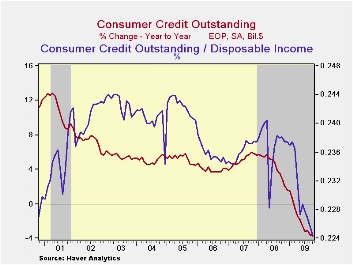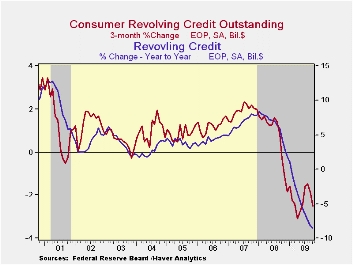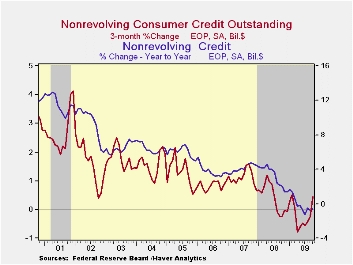 Global| Dec 08 2009
Global| Dec 08 2009U.S. Consumer Credit Outstanding Drops; Earlier Declines Shaved
by:Tom Moeller
|in:Economy in Brief
Summary
The Federal Reserve reported yesterday that consumer credit outstanding fell by $3.5B m/m during October. While it was the thirteenth monthly drop since summer 2008, earlier declines were trimmed. And though consumer credit [...]
 The
Federal Reserve reported yesterday that consumer credit outstanding
fell by $3.5B m/m during October. While it was the thirteenth monthly
drop since summer 2008, earlier declines were trimmed. And though
consumer credit outstanding as a percentage of disposable income has
fallen to 22.4% from its 2005 high of 24.7%, these rates are up from
the low near 16% in the early-1990s.
The
Federal Reserve reported yesterday that consumer credit outstanding
fell by $3.5B m/m during October. While it was the thirteenth monthly
drop since summer 2008, earlier declines were trimmed. And though
consumer credit outstanding as a percentage of disposable income has
fallen to 22.4% from its 2005 high of 24.7%, these rates are up from
the low near 16% in the early-1990s.
 The recent
improvement
in consumer sentiment may be reducing the aversion to credit. Consumers
during October actually raised their level of non-revolving credit for
the third month this year. Declines earlier in 2009 were revised
sharply shallower and the recent three-month change of +0.5% compares
to this year's deepest of -0.8% during April. Usage of non-revolving
credit (autos & other consumer durables), which accounts for
nearly two-thirds of the total, fell $6.9B after an $8.7B September
decline that was deeper than reported initially, as were earlier
declines. The 8.5% y/y decline was by far a record.
The recent
improvement
in consumer sentiment may be reducing the aversion to credit. Consumers
during October actually raised their level of non-revolving credit for
the third month this year. Declines earlier in 2009 were revised
sharply shallower and the recent three-month change of +0.5% compares
to this year's deepest of -0.8% during April. Usage of non-revolving
credit (autos & other consumer durables), which accounts for
nearly two-thirds of the total, fell $6.9B after an $8.7B September
decline that was deeper than reported initially, as were earlier
declines. The 8.5% y/y decline was by far a record.
 Savings
institutions actually raised their level of lending during the last
three months (-3.5% y/y). Commercial bank loans were stable,
though still down a sharp 3.6% y/y. Loans from credit unions also
increased slightly since the spring (1.9% y/y) and the Federal
government & Sallie Mae raised their level of credit
outstanding by more than two-thirds y/y.
Savings
institutions actually raised their level of lending during the last
three months (-3.5% y/y). Commercial bank loans were stable,
though still down a sharp 3.6% y/y. Loans from credit unions also
increased slightly since the spring (1.9% y/y) and the Federal
government & Sallie Mae raised their level of credit
outstanding by more than two-thirds y/y.
These figures are the major input to the Fed's quarterly Flow of Funds accounts for the household sector.
Credit data are available in Haver's USECON database. The Flow of Funds data are in Haver's FFUNDS database.
Rescuing asset-backed securities markets from the Federal Reserve Bank of Chicago can be found here.
| Consumer Credit Outstanding (m/m Chg, SAAR) | October | September | Y/Y | 2008 | 2007 | 2006 |
|---|---|---|---|---|---|---|
| Total | $-3.5B | $-8.7B | -3.6% | 1.6% | 5.6% | 4.1% |
| Revolving | $-6.9B | $-8.0B | -8.5% | 1.9% | 7.8% | 5.0% |
| Non-revolving | $3.5B | $-0.9B | -0.6% | 1.4% | 4.4% | 3.6% |
Tom Moeller
AuthorMore in Author Profile »Prior to joining Haver Analytics in 2000, Mr. Moeller worked as the Economist at Chancellor Capital Management from 1985 to 1999. There, he developed comprehensive economic forecasts and interpreted economic data for equity and fixed income portfolio managers. Also at Chancellor, Mr. Moeller worked as an equity analyst and was responsible for researching and rating companies in the economically sensitive automobile and housing industries for investment in Chancellor’s equity portfolio. Prior to joining Chancellor, Mr. Moeller was an Economist at Citibank from 1979 to 1984. He also analyzed pricing behavior in the metals industry for the Council on Wage and Price Stability in Washington, D.C. In 1999, Mr. Moeller received the award for most accurate forecast from the Forecasters' Club of New York. From 1990 to 1992 he was President of the New York Association for Business Economists. Mr. Moeller earned an M.B.A. in Finance from Fordham University, where he graduated in 1987. He holds a Bachelor of Arts in Economics from George Washington University.






